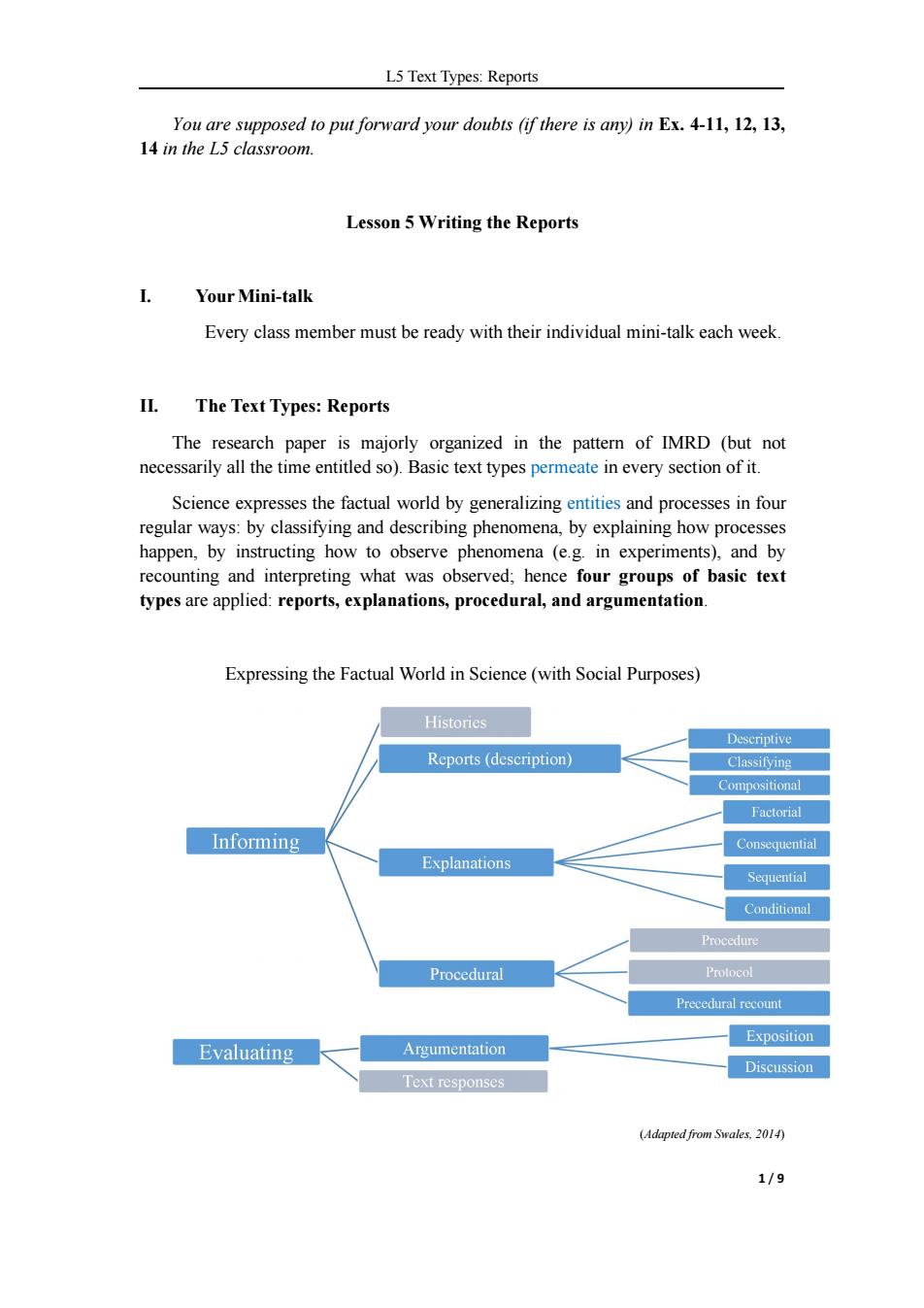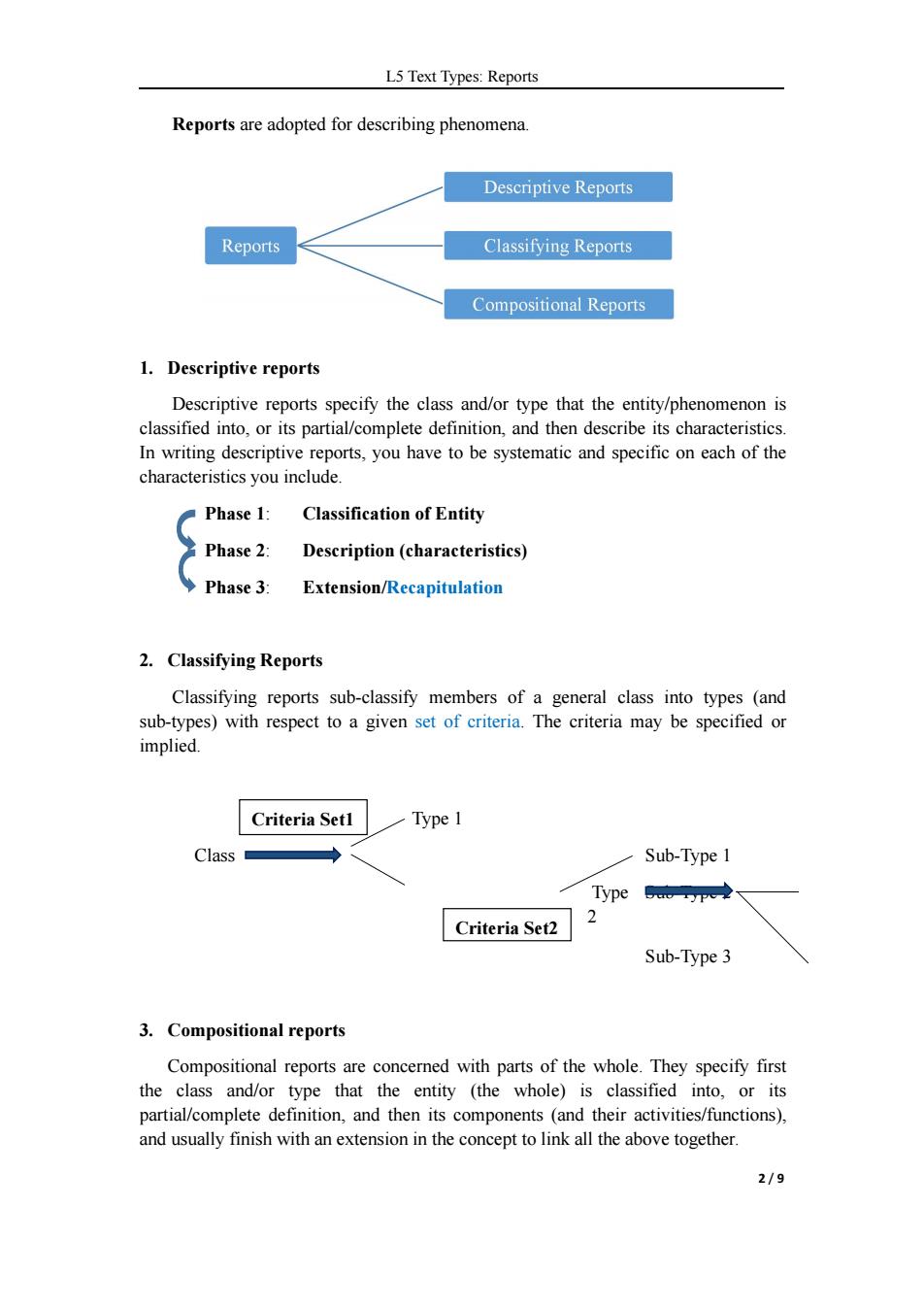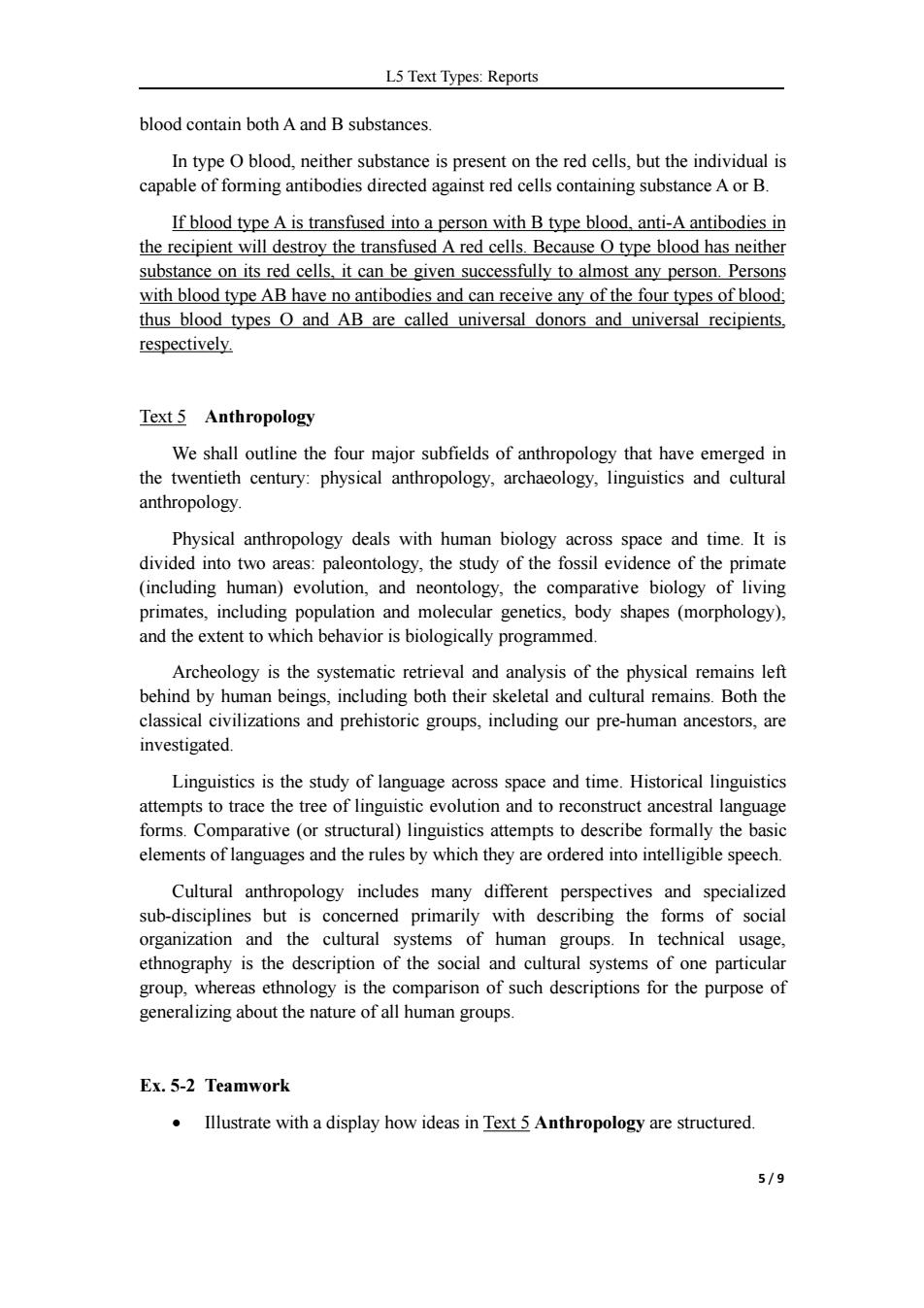
L5 Text Types:Reports You are supposed to put forward your doubts (if there is any)in Ex.4-11,12,13, 14 in the L5 classroom. Lesson 5 Writing the Reports I. Your Mini-talk Every class member must be ready with their individual mini-talk each week. II.The Text Types:Reports The research paper is majorly organized in the pattern of IMRD (but not necessarily all the time entitled so).Basic text types permeate in every section of it Science expresses the factual world by generalizing entities and processes in four regular ways:by classifying and describing phenomena,by explaining how processes happen,by instructing how to observe phenomena (e.g.in experiments),and by recounting and interpreting what was observed;hence four groups of basic text types are applied:reports,explanations,procedural,and argumentation. Expressing the Factual World in Science (with Social Purposes) Histories Descriptive Reports(description) Classifying Compositional Factorial Informing Consequential Explanations Sequential Conditional Procedure Procedural Protocol Precedural recount Exposition Evaluating Argumentation Discussion Text responses (Adapted from Swales,2014) 1/9
L5 Text Types: Reports 1 / 9 You are supposed to put forward your doubts (if there is any) in Ex. 4-11, 12, 13, 14 in the L5 classroom. Lesson 5 Writing the Reports I. YourMini-talk Every class member must be ready with their individual mini-talk each week. II. The Text Types: Reports The research paper is majorly organized in the pattern of IMRD (but not necessarily all the time entitled so). Basic text types permeate in every section of it. Science expresses the factual world by generalizing entities and processes in four regular ways: by classifying and describing phenomena, by explaining how processes happen, by instructing how to observe phenomena (e.g. in experiments), and by recounting and interpreting what was observed; hence four groups of basic text types are applied: reports, explanations, procedural, and argumentation. Expressing the Factual World in Science (with Social Purposes) (Adapted from Swales, 2014)

L5 Text Types:Reports Reports are adopted for describing phenomena. Descriptive Reports Reports Classifying Reports Compositional Reports 1.Descriptive reports Descriptive reports specify the class and/or type that the entity/phenomenon is classified into,or its partial/complete definition,and then describe its characteristics. In writing descriptive reports,you have to be systematic and specific on each of the characteristics you include. Phase 1:Classification of Entity Phase 2:Description(characteristics) Phase 3: Extension/Recapitulation 2.Classifying Reports Classifying reports sub-classify members of a general class into types (and sub-types)with respect to a given set of criteria.The criteria may be specified or implied. Criteria Setl Type 1 Class Sub-Type 1 Type 2 Criteria Set2 Sub-Type 3 3.Compositional reports Compositional reports are concerned with parts of the whole.They specify first the class and/or type that the entity (the whole)is classified into,or its partial/complete definition,and then its components (and their activities/functions), and usually finish with an extension in the concept to link all the above together. 2/9
L5 Text Types: Reports 2 / 9 Reports are adopted for describing phenomena. 1. Descriptive reports Descriptive reports specify the class and/or type that the entity/phenomenon is classified into, or its partial/complete definition, and then describe its characteristics. In writing descriptive reports, you have to be systematic and specific on each of the characteristics you include. Phase 1: Classification of Entity Phase 2: Description (characteristics) Phase 3: Extension/Recapitulation 2. Classifying Reports Classifying reports sub-classify members of a general class into types (and sub-types) with respect to a given set of criteria. The criteria may be specified or implied. Criteria Set1 Type 1 Class Sub-Type 1 Type 2 Criteria Set2 Sub-Type 2 Sub-Type 3 3. Compositional reports Compositional reports are concerned with parts of the whole. They specify first the class and/or type that the entity (the whole) is classified into, or its partial/complete definition, and then its components (and their activities/functions), and usually finish with an extension in the concept to link all the above together

L5 Text Types:Reports Phase 1:Classification of Entity Phase 2: Components (their characteristics) Phase 3: Extension/Recapitulation 4.Differentiating types of reports Ex.5-1 Read the following texts,and determine what type of reports they respectively are. Make sure that you identify the structure and elements of the particular type of reports in each of them. Text 1 Goannas Australia is home to 25 of the world's 30 monitor lizard species.In Australia, monitor lizards are called goannas. Goannas have flattish bodies,long tails and strong jaws.They are the only lizards with forked tongues,like a snake.Their necks are long and may have loose folds of skin beneath them.Their legs are long and strong,with sharp claws on their feet. Many goannas have stripes,spots and other markings that help to camouflage them. The largest species can grow to more than two meters in length. All goannas are daytime hunters.They run,climb and swim well.Goannas hunt small mammals,birds and other reptiles.They also eat dead animals.Smaller goannas eat insects,spiders and worms. Male goannas fight with each other in the breeding season.Females lay between two and twelve eggs. Text 2 Mangroves When you walk into a mangrove forest,you may at first think that grey mangroves are the only living organisms there.However,look and listen and you will find evidence of other living occupants of the forest.Many different kinds of organisms share the living space with the grey mangroves. Fish and shrimp are found in the brackish waters.At low tide,you may notice small crabs scurrying into burrows in the mud.Even if you miss the crabs you will see evidence of their presence from holes in the mud leading to their burrows. At low-tide periods,various mollusks,such as snails and whelks,graze on algae that form a green film on parts of the muddy forest floor.Spiders spin their webs between branches of the grey mangroves to catch passing insects.Lichens grow on the trunks of mature mangrove trees.Many bird species feed on the nectar and pollen 3/9
L5 Text Types: Reports 3 / 9 Phase 1: Classification of Entity Phase 2: Components (& their characteristics) Phase 3: Extension/Recapitulation 4. Differentiating types of reports Ex. 5-1 Read the following texts, and determine what type of reports they respectively are. Make sure that you identify the structure and elements of the particular type of reports in each of them. Text 1 Goannas Australia is home to 25 of the world's 30 monitor lizard species. In Australia, monitor lizards are called goannas. Goannas have flattish bodies, long tails and strong jaws. They are the only lizards with forked tongues, like a snake. Their necks are long and may have loose folds of skin beneath them. Their legs are long and strong, with sharp claws on their feet. Many goannas have stripes, spots and other markings that help to camouflage them. The largest species can grow to more than two meters in length. All goannas are daytime hunters. They run, climb and swim well. Goannas hunt small mammals, birds and other reptiles. They also eat dead animals. Smaller goannas eat insects, spiders and worms. Male goannas fight with each other in the breeding season. Females lay between two and twelve eggs. Text 2 Mangroves When you walk into a mangrove forest, you may at first think that grey mangroves are the only living organisms there. However, look and listen and you will find evidence of other living occupants of the forest. Many different kinds of organisms share the living space with the grey mangroves. Fish and shrimp are found in the brackish waters. At low tide, you may notice small crabs scurrying into burrows in the mud. Even if you miss the crabs you will see evidence of their presence from holes in the mud leading to their burrows. At low-tide periods, various mollusks, such as snails and whelks, graze on algae that form a green film on parts of the muddy forest floor. Spiders spin their webs between branches of the grey mangroves to catch passing insects. Lichens grow on the trunks of mature mangrove trees. Many bird species feed on the nectar and pollen

L5 Text Types:Reports of the mangrove flowers and on the insects that live in the mangrove trees.At low tide, mudflats on the deep water side of the mangrove forests are feeding sites for other bird species,such as the striated heron,Ardeola striatus,that feeds on snails and crabs. All these different kinds of organisms are part of the living community of the mangrove forest. Text 3 Ergonomics Ergonomics(人体工程学)can be defined as the design of work so that the best is made of human capabilities without exceeding human limitations. Standards Association of Australia.Australian Standard 1837-1976:Ergonomics in Factory and Office Work, Standards Australia,North Sydney,1976. The evolution of a product or design based on ergonomics relates the product or design to the physical needs of the user.These physical needs include not only size and position but other aspects such as floor surfaces,illumination levels,hand grips, switch standards and vision. Understanding the physical needs of the user allows the designer to cater for individual differences and to create products that cater for the needs of the majority of consumers.Ergonomics is to do with the human body as a whole but it also involves the function of parts of the body and the ease with which humans perform simple tasks. Text 4 Blood Type Blood Type,in medicine,is the classification of red blood cells by the presence of specific substances on their surface.Typing of red blood cells is a prerequisite for blood transfusion.In the early part of the 20th century,physicians discovered that blood transfusions often failed because the blood type of the recipient was not compatible with that of the donor.In 1901 the Austrian pathologist Karl Landsteiner classified blood types and discovered that they were transmitted by Mendelian heredity.The four blood types are known as A,B,AB,and O Blood type A contains red blood cells that have a substance A on their surface. This type of blood also contains an antibody directed against substance B,found on the red cells of persons with blood type B. Type B blood contains the reverse combination. Serum of blood type AB contains neither antibody,but red cells in this type of 4/9
L5 Text Types: Reports 4 / 9 of the mangrove flowers and on the insects that live in the mangrove trees. At low tide, mudflats on the deep water side of the mangrove forests are feeding sites for other bird species, such as the striated heron, Ardeola striatus, that feeds on snails and crabs. All these different kinds of organisms are part of the living community of the mangrove forest. Text 3 Ergonomics Ergonomics (人体工程学) can be defined as the design of work so that the best is made of human capabilities without exceeding human limitations. Standards Association of Australia, Australian Standard 1837-1976: Ergonomics in Factory and Of ice Work, Standards Australia, North Sydney, 1976. The evolution of a product or design based on ergonomics relates the product or design to the physical needs of the user. These physical needs include not only size and position but other aspects such as floor surfaces, illumination levels, hand grips, switch standards and vision. Understanding the physical needs of the user allows the designer to cater for individual differences and to create products that cater for the needs of the majority of consumers. Ergonomics is to do with the human body as a whole but it also involves the function of parts of the body and the ease with which humans perform simple tasks. Text 4 Blood Type Blood Type, in medicine, is the classification of red blood cells by the presence of specific substances on their surface. Typing of red blood cells is a prerequisite for blood transfusion. In the early part of the 20th century, physicians discovered that blood transfusions often failed because the blood type of the recipient was not compatible with that of the donor. In 1901 the Austrian pathologist Karl Landsteiner classified blood types and discovered that they were transmitted by Mendelian heredity. The four blood types are known as A, B, AB, and O. Blood type A contains red blood cells that have a substance A on their surface. This type of blood also contains an antibody directed against substance B, found on the red cells of persons with blood type B. Type B blood contains the reverse combination. Serum of blood type AB contains neither antibody, but red cells in this type of

L5 Text Types:Reports blood contain both A and B substances. In type O blood,neither substance is present on the red cells,but the individual is capable of forming antibodies directed against red cells containing substance A or B. If blood type A is transfused into a person with B type blood,anti-A antibodies in the recipient will destroy the transfused A red cells.Because O type blood has neither substance on its red cells,it can be given successfully to almost any person.Persons with blood type ab have no antibodies and can receive any of the four types of blood; thus blood types O and AB are called universal donors and universal recipients, respectively. Text 5 Anthropology We shall outline the four major subfields of anthropology that have emerged in the twentieth century:physical anthropology,archaeology,linguistics and cultural anthropology. Physical anthropology deals with human biology across space and time.It is divided into two areas:paleontology,the study of the fossil evidence of the primate (including human)evolution,and neontology,the comparative biology of living primates,including population and molecular genetics,body shapes (morphology), and the extent to which behavior is biologically programmed. Archeology is the systematic retrieval and analysis of the physical remains left behind by human beings,including both their skeletal and cultural remains.Both the classical civilizations and prehistoric groups,including our pre-human ancestors,are investigated. Linguistics is the study of language across space and time.Historical linguistics attempts to trace the tree of linguistic evolution and to reconstruct ancestral language forms.Comparative (or structural)linguistics attempts to describe formally the basic elements of languages and the rules by which they are ordered into intelligible speech. Cultural anthropology includes many different perspectives and specialized sub-disciplines but is concerned primarily with describing the forms of social organization and the cultural systems of human groups.In technical usage, ethnography is the description of the social and cultural systems of one particular group,whereas ethnology is the comparison of such descriptions for the purpose of generalizing about the nature of all human groups. Ex.5-2 Teamwork Illustrate with a display how ideas in Text 5 Anthropology are structured. 5/9
L5 Text Types: Reports 5 / 9 blood contain both A and B substances. In type O blood, neither substance is present on the red cells, but the individual is capable of forming antibodies directed against red cells containing substance A or B. If blood type A is transfused into a person with B type blood, anti-A antibodies in the recipient will destroy the transfused A red cells. Because O type blood has neither substance on its red cells, it can be given successfully to almost any person. Persons with blood type AB have no antibodies and can receive any of the four types of blood; thus blood types O and AB are called universal donors and universal recipients, respectively. Text 5 Anthropology We shall outline the four major subfields of anthropology that have emerged in the twentieth century: physical anthropology, archaeology, linguistics and cultural anthropology. Physical anthropology deals with human biology across space and time. It is divided into two areas: paleontology, the study of the fossil evidence of the primate (including human) evolution, and neontology, the comparative biology of living primates, including population and molecular genetics, body shapes (morphology), and the extent to which behavior is biologically programmed. Archeology is the systematic retrieval and analysis of the physical remains left behind by human beings, including both their skeletal and cultural remains. Both the classical civilizations and prehistoric groups, including our pre-human ancestors, are investigated. Linguistics is the study of language across space and time. Historical linguistics attempts to trace the tree of linguistic evolution and to reconstruct ancestral language forms. Comparative (or structural) linguistics attempts to describe formally the basic elements of languages and the rules by which they are ordered into intelligible speech. Cultural anthropology includes many different perspectives and specialized sub-disciplines but is concerned primarily with describing the forms of social organization and the cultural systems of human groups. In technical usage, ethnography is the description of the social and cultural systems of one particular group, whereas ethnology is the comparison of such descriptions for the purpose of generalizing about the nature of all human groups. Ex. 5-2 Teamwork Illustrate with a display how ideas in Text 5 Anthropology are structured